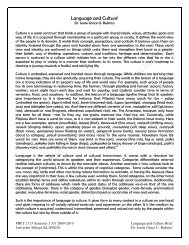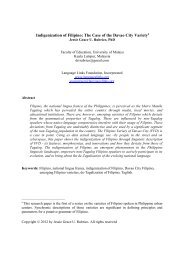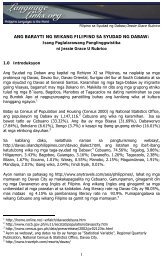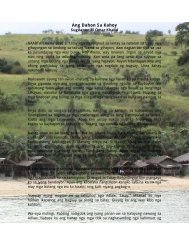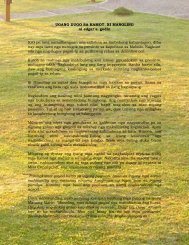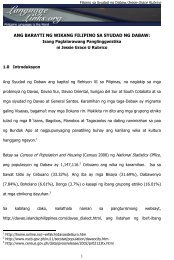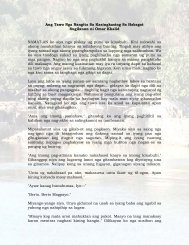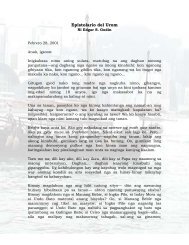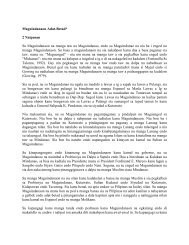Filipino Variety of Davao - Languagelinks.org
Filipino Variety of Davao - Languagelinks.org
Filipino Variety of Davao - Languagelinks.org
Create successful ePaper yourself
Turn your PDF publications into a flip-book with our unique Google optimized e-Paper software.
<strong>Filipino</strong> <strong>Variety</strong> <strong>of</strong> <strong>Davao</strong>: A Linguistic Description<br />
Jessie Grace U. Rubrico, PhD<br />
Faculty <strong>of</strong> Education<br />
University <strong>of</strong> Malaya<br />
drrubrico@gmail.com<br />
ABSTRACT<br />
<strong>Filipino</strong> is the evolving national language <strong>of</strong> the Philippines. Many believe that it is the<br />
Tagalog variety <strong>of</strong> Metro Manila which has pervaded the entire country through the<br />
media, local movies, and educational institutions. There are, however, emerging varieties<br />
<strong>of</strong> <strong>Filipino</strong> which deviate from the grammatical properties <strong>of</strong> Tagalog. These are<br />
influenced by non-Tagalog speakers whose native language competencies interfere with<br />
their usage <strong>of</strong> <strong>Filipino</strong>. These Tagalog deviants are undeniably distinctive and are used<br />
by a significant segment <strong>of</strong> the non-Tagalog population in the country. The <strong>Filipino</strong><br />
<strong>Variety</strong> <strong>of</strong> <strong>Davao</strong> City (FVD) is a case in point. This paper describes FVD - its features,<br />
morphosyntax, and innovations and how they deviate from those <strong>of</strong> Tagalog. Using as<br />
data the language used by people on the streets and the cyberspace, it is observed that<br />
this type <strong>of</strong> variety allows its speakers to freely explore <strong>Filipino</strong> without the hindrance<br />
<strong>of</strong> “correct grammar” as defined by the <strong>Filipino</strong> language authorities in<br />
Manila. Indigenizing <strong>Filipino</strong> is an emergent phenomenon in the Philippine linguistic<br />
landscape. It empowers non-Tagalog <strong>Filipino</strong> speakers to actively participate in its<br />
evolution, and to bring about the de-Tagalization <strong>of</strong> the national language.<br />
Keywords: evolution <strong>of</strong> <strong>Filipino</strong>, varieties <strong>of</strong> <strong>Filipino</strong>, de-Tagalization,<br />
indigenization <strong>of</strong> <strong>Filipino</strong>, Taglish, Bislog, Tagbis<br />
*Paper read at the 11 th Philippine Linguistics Congress, NISMED University <strong>of</strong> the Philippines,<br />
Diliman, Quezon City, 7-9 December 2011.
Rubrico, J.G.U. 2011. <strong>Filipino</strong> <strong>Variety</strong> <strong>of</strong> <strong>Davao</strong>: A Linguistic Description<br />
1.0 Introduction<br />
<strong>Davao</strong> City is the capital <strong>of</strong> Region XI, which includes the provinces <strong>of</strong> <strong>Davao</strong> del Norte, <strong>Davao</strong><br />
del Sur, <strong>Davao</strong> Oriental, and the Compostela Valley. Its population <strong>of</strong> 4,156,653 (2007 census) 1<br />
generally speaks Cebuano, 2 although English and <strong>Filipino</strong> are also widely spoken. English is<br />
used in institutions <strong>of</strong> learning as well as in commerce and trade. However, next to Cebuano,<br />
<strong>Filipino</strong> is widely spoken by the people <strong>of</strong> <strong>Davao</strong>.<br />
<strong>Filipino</strong> is the evolving national language <strong>of</strong> the Philippines, as provided for by the 1987<br />
Constitution (Art. XIV, Sec. 6). In the process <strong>of</strong> its evolution, it is used as the country’s lingua<br />
franca, a code by which <strong>Filipino</strong> people from different regions <strong>of</strong> the country can communicate.<br />
Many consider <strong>Filipino</strong> as the Tagalog variety <strong>of</strong> Metro Manila which has pervaded the entire<br />
country through the media, local movies, and educational institutions. It borrows heavily from<br />
English. Thus, it is <strong>of</strong>ten called Taglish, a blend <strong>of</strong> the clips Tag(alog) and (Eng)lish. The<br />
<strong>Filipino</strong> language is understood by almost all <strong>Filipino</strong>s. The 2000 Census <strong>of</strong> Population and<br />
Housing reports that about ninety-six percent (96.4%) <strong>of</strong> the household population who have<br />
gone to school can speak <strong>Filipino</strong>. Figure 1 shows the percentages <strong>of</strong> population aged 5 years old<br />
or over who can speak <strong>Filipino</strong> across regions.<br />
Figure 1 Percentage <strong>of</strong> <strong>Filipino</strong>-speaking <strong>Filipino</strong>s by Region<br />
Source: http://www.census.gov.ph/data/sectordata/sr05153tx.html<br />
Be that as it may, there are emerging varieties <strong>of</strong> <strong>Filipino</strong> which deviate from the grammatical<br />
properties <strong>of</strong> the Metro Manila Tagalog. These are influenced by non-Tagalog speakers whose<br />
native languages interfere with their usage <strong>of</strong> <strong>Filipino</strong>. These Tagalog deviants (nonstandard) are<br />
undeniably distinctive and are used by a significant segment <strong>of</strong> the non-Tagalog population in<br />
the country. The <strong>Filipino</strong> <strong>Variety</strong> <strong>of</strong> <strong>Davao</strong> City (FVD) is a case in point. This paper gives a<br />
linguistic description <strong>of</strong> FVD - its features, morphosyntax, and innovations and explores how<br />
these differ from those <strong>of</strong> Tagalog. Data for this study is the actual language used by people on<br />
1 http://www.nscb.gov.ph/ru11/ [National Statistical Coordination Board Regional Division XI (<strong>Davao</strong> Region)]<br />
2 http://www.census.gov.ph/data/pressrelease/2002/pr02123tx.html<br />
2
Rubrico, J.G.U. 2011. <strong>Filipino</strong> <strong>Variety</strong> <strong>of</strong> <strong>Davao</strong>: A Linguistic Description<br />
the streets and the cyberspace collected from 2006 to 2008. Though much <strong>of</strong> the data used here<br />
are from the cyberspace – i.e., blogs <strong>of</strong> some Davaweños and online publications, data from<br />
fieldwork have shown that this variety is also used in the day-to-day Davaweño discourse. This<br />
study documents how speakers freely explore the <strong>Filipino</strong> language in their own context.<br />
2.0 The <strong>Davao</strong> City variety <strong>of</strong> <strong>Filipino</strong><br />
2.1 Two types <strong>of</strong> <strong>Filipino</strong> are noted in <strong>Davao</strong> City. The English-<strong>Filipino</strong> mix, very much like the<br />
FMM as shown in examples (a) 3 and (b) 4 taken from weblogs and (c and d) from billboards<br />
along the highway. The italicized words are borrowed from English in their original spelling.<br />
a) Nagpapakaserious sa work and naglilibang sa net kung bakit pa kasi ako nainlove.<br />
Eng: pretending to be serious at work and keeping busy at the internet, why did I have to<br />
fall in love.<br />
b) Bro, dont do that... naglilibang si pareng bobby alvarez, eh...<br />
Eng: brother. . . . . .our friend bobby alvarez is relaxing, you know.<br />
c) Let’s go na po, sa paborito nato!<br />
Eng: Come now, let’s go, to our favorite (place)!<br />
d) Dad, I love it here, BUY NA, NOW NA!<br />
Eng: . . . . . . . . . . buy now, this instant.<br />
Two things are noted in clauses (a-b) and (d): the English-<strong>Filipino</strong> code-mix and the use <strong>of</strong><br />
grammar rules <strong>of</strong> Tagalog in phrases construction. Except for (c) which exhibits a three-language<br />
code-mix, English-Tagalog-Bisaya, with BIS nato (TAGnatin, ENGour), this variety is very<br />
similar to FMM, thus, will not be discussed any further.<br />
2.2 The second type is the Bisaya 5 - Tagalog blend. Lizada calls this Tagalog na Binisaya in his<br />
column, Papa's Table, in Sunstar. 6 This is also casually referred to as TAGBIS, the Tag(alog)<br />
and Bis(aya) clips blend, or BISLOG from Bis(ayang) (Taga)log. 7 For the purpose <strong>of</strong> this paper,<br />
TAGBIS is the <strong>Filipino</strong> variety <strong>of</strong> <strong>Davao</strong> (FVD). Note sample sentences (2a-c) taken from<br />
Tagalog na Binisaya and (2d-e) from Galenga Talaga Niya Gyud, Uy! 8<br />
3 Source: www.tristancafe.com/forum/46<br />
4 Source:mannypacquiao.ph/forum/viewtopic.php?t=12132&sid=996b764ed88d5d35bfd3c495f4a7cb63.<br />
5 The people <strong>of</strong> Mindanao call their language Bisaya or Binisaya. For them, Cebuano is the language <strong>of</strong> the people <strong>of</strong><br />
Cebu. Bisaya and Cebuano mean the same in this paper and are used interchangeably.<br />
6 http://www.sunstar.com.ph/static/dav/2005/01/19/life/lizada.tagalog.na.binasaya.html<br />
7 From bisayabloggers.blogspot.com/2005_04_01_bisayabloggers_archive.html<br />
8 http://thespoke.net/blogs/yeoj/archive/2006/01/12/931047.aspx<br />
3
Rubrico, J.G.U. 2011. <strong>Filipino</strong> <strong>Variety</strong> <strong>of</strong> <strong>Davao</strong>: A Linguistic Description<br />
2a) Dahil wala akong magawa ay naglibang-libang ako.<br />
Because neg 1SGen-link do-Apt IM amuse-Perf 1PNom 9<br />
Because I could do nothing, I amused myself /kept myself occupied.<br />
2b) Wag lang dagat na magtabok kami dahil takot akong sumakay<br />
neg just sea that ConAF-cross 1PNom because afraid 1SGenlinker board- ConAF<br />
ng bangka para tumabok.<br />
indefM canoe to cross<br />
Not just the sea where we need to cross because I’m afraid to board a canoe to cross.<br />
2c) mas mabuti kung muhawa na lang mi kay kusog lagi 10 ang ulan!<br />
more good if AFleave-Con just 1PGen because hard part the rain<br />
It is better if we just leave because the rain is really hard (it’s raining really hard)<br />
The Verbnaglibang-libang in the context <strong>of</strong> (2a) is from TAGlibang (to amuse or to keep busy),<br />
which does not appear in this form (viz., V af –Rootlibang-totalRedupl) 11 in TAG. In BIS, libang<br />
affixed with ma- means “to defecate.” Libang does not co-occur with the affix mag- in BIS. In<br />
(2b), BIS root tabok (TAGtawid) is affixed by mag- and –um- to mean “to cross”. Do we see BIS<br />
rootwords here with Tagalog affixes?<br />
The sentence in (2c) is Bisaya with TAGmabuti, verb muhawa (rootword: hawa, TAGalis;<br />
English depart); the phrase ang ulan is both BIS and TAG.<br />
It can be seen from the examples that, generally, TAG words dominate this code-mix. Yet,<br />
speakers <strong>of</strong>ten use the words most convenient and natural for them (viz., Bisaya). This is shown<br />
in the insertion <strong>of</strong> BIS particles in clauses (2d and e).<br />
2d) Mabait bitaw 12 gyud si Weng<br />
good-natured part<br />
really AM 13 Weng<br />
Tag: Totoong mabait talaga si Weng.<br />
Eng: Weng is really good-natured.<br />
9 Abbreviations: neg, negative; 1SGen-link, 1stPerson-Singular-Genetive-Linker; Apt, Aptative; IM,<br />
Inversion Marker; Perf, Perfected; 1PNom, 1stPerson Plural Nominative; ConAF, Contemplated-ActorFocus;<br />
indefM, indefinite Marker; 1PGen, 1stPerson Genetive.<br />
10 BIS particle lagi puts emphasis on what is stated.<br />
11 V af –Rootlibang-totalRedupl, Verbal affix-. . .-total reduplication<br />
12 BIS particle bitaw signifies agreement on what is being stated.<br />
13 AM, actor marker<br />
4
Rubrico, J.G.U. 2011. <strong>Filipino</strong> <strong>Variety</strong> <strong>of</strong> <strong>Davao</strong>: A Linguistic Description<br />
2e) Galenga talaga niya gyud, 14 uy! 15<br />
excellent really 3SGen part<br />
Tag: Ang galing niya talaga!<br />
Eng: She really is excellent!<br />
Besides the particles, note the two morphemes in galenga, [galeng and –a], in (2e). The<br />
morpheme –a is usually affixed to BIS adjectives to express intensity, like dakoa (how big),<br />
gamaya (how little or how small).<br />
Going back to (2a to c), note that affixation <strong>of</strong> BIS verbal affixes to TAG roots are done in<br />
accordance with the morphological rules <strong>of</strong> BIS. This is one <strong>of</strong> the characteristics <strong>of</strong> FVD. Other<br />
examples are given below:<br />
2f) Hindi pa 16 man siya nag-dating, uy. 17<br />
neg part<br />
part 3SNom ProgAF-arrive part<br />
Tag: Hindi pa siya dumating kasi.<br />
Eng: S/he has not arrived yet. (What’s taking her/him so long?)<br />
2g) Ayaw kasi nilang mag-lapit sa akin, di ayaw ko na ring<br />
neg<br />
because 3PGenLinker ConAF-come near to 1SLoc so neg 1SNOm part part<br />
maglapit sa kanila. 18<br />
to 3Ploc<br />
Tag: Ayaw kasi nilang lumapit sa akin, kaya ayaw ko na ring lumapit sa kanila.<br />
Eng: Because they don’t want to come near me, so I don’t also want to go near them.<br />
From the foregoing examples, it is shown that the TAG V af –um- is generally replaced with magin<br />
FVD. In (2h), BIS V af gi- is affixed to TAGsabi and in (2i) BIS V af maka- is used in<br />
accordance with BIS morphosyntax. Note the BIS translation <strong>of</strong> the clause.<br />
14 BIS particle gyud from gayud expresses certainty<br />
15 BIS uy is clause final particle here expressing delight or surprise<br />
16 BIS particle pa means “yet”; The TAGhindi pa phrase here means “not yet.”<br />
17 BIS uy particle final here expresses irritation or anxiety.<br />
18 Source <strong>of</strong> (2g and h): “Pagkakaisa sa Gitna ng Pagkakaiba-iba,” a homily delivered by Pastor Roderick<br />
Raut to the Tagalog congregation <strong>of</strong> the <strong>Davao</strong> City UCCP on May 2004.<br />
5
Rubrico, J.G.U. 2011. <strong>Filipino</strong> <strong>Variety</strong> <strong>of</strong> <strong>Davao</strong>: A Linguistic Description<br />
2h) Gisabi kasi ni Helen na mag-absent si Bernard bukas<br />
PerfOF 19 -say because AM Helen that ConAF-absent AM Bernard tomorrow<br />
Tag: Sinabi kasi ni Helen na aabsent si Bernard bukas.<br />
Eng: Because Helen said that Bernard will be absent tomorrow<br />
2i) Maka-inis man yan siya, uy!<br />
AptCon-irritate part that 1SNom part<br />
Tag: Nakakainis talaga siya!<br />
Bis: Makalagot man na siya uy!<br />
Eng: S/he really makes one mad!<br />
One remarkable innovation in FVD is the nakin form <strong>of</strong> TAGko, as shown in (2j) and (2k).<br />
2j) Alam man nakin `yan ba!<br />
know part 1PNom that part<br />
Tag: Alam ko na man yan.<br />
Eng: I already know that.<br />
2k) Saan nakin kita 20 nakita gani 21 ?<br />
where 1SNom PerfAF-see part<br />
Tag: Saan nga ba kita nakita?<br />
Eng: Where have I seen you before?<br />
3. Features <strong>of</strong> FVD; how do they differ from those <strong>of</strong> Tagalog?<br />
3.1 The combination <strong>of</strong> words from BIS and TAG in a clause, including the insertion <strong>of</strong> BIS<br />
particles, like bitaw gyud, lagi ba, gyud, uy. This code-mixing is adopted by FVD speakers. 22<br />
Bringing the BIS lexicon into the FVD is a step toward enrichment <strong>of</strong> the evolving national<br />
language. Note the English-Tagalog code-mix in FMM and the <strong>Filipino</strong>-Bisaya code-mix in<br />
FVD. This is the first difference between these two varieties <strong>of</strong> <strong>Filipino</strong>.<br />
19 PerfOF, perfected Object Focus<br />
20 Kita is a Tagalog pronoun that express the I-You paradigm as in Mahal Kita (I love you) or Isumbong kita<br />
(I’ll tell on you).<br />
21 BIS particle gani is used here to express remembrance <strong>of</strong> something or someone.<br />
22 In FMM, the code-mixing is English and Tagalog.<br />
6
Rubrico, J.G.U. 2011. <strong>Filipino</strong> <strong>Variety</strong> <strong>of</strong> <strong>Davao</strong>: A Linguistic Description<br />
3.2 The application <strong>of</strong> BIS morphosyntactic rules on TAG morphemes in the clause.<br />
3.2.1 The suffixing <strong>of</strong> –a to adjectives to convey their intensive form, like in (2e) where –a is<br />
suffixed to adjective galing, deriving galenga. This is not grammatical in Tagalog which marks<br />
the adjective with ang instead; (2l) below is ill-formed in TAG; (2m) is the acceptable:<br />
2l) *Galenga ni Kulasa!<br />
2m) Ang galing ni Kulasa!<br />
Eng: How excellent Kulasa is!<br />
3.2.2 The affixation <strong>of</strong> BISV af on TAG lexical items (words) to derive FVD verbs. Additionally,<br />
BISV af mag- or nag- is used in lieu <strong>of</strong> TAG –um- and V af gi- in lieu <strong>of</strong> TAG –in- (2h). This<br />
[BIS + TAG] morphemes merger in verb derivation distinguishes FVD from Tagalog or FMM.<br />
3.3 The FVD pronoun nakin innovation. This pronoun is neither Tagalog nor Bisaya. This<br />
distinguishes FVD from both Tagalog and Bisaya. The researcher is not sure whether there are<br />
other such pronoun innovations in FVD. Further study is needed to come up with conclusive<br />
statements on this.<br />
There may be other features <strong>of</strong> FVD which are not mentioned in this paper. This is a seminal<br />
study which hopes to initiate more research documenting the use <strong>of</strong> <strong>Filipino</strong> by non-Tagalog<br />
speakers as it evolves into the constitutionally-mandated national language.<br />
4. Conclusion<br />
This paper presents a linguistic description <strong>of</strong> the FVD. Two features are found to be different<br />
from those <strong>of</strong> Tagalog and its Metro Manila variety, the FMM. Firstly, FVD mixes Bisaya-<br />
Tagalog codes, while FMM employs the English-Tagalog code-mix. Secondly, FMM adheres to<br />
the grammar <strong>of</strong> Tagalog while FVD sticks to the grammar <strong>of</strong> Bisaya. Can TAG words derived<br />
through BIS morphosyntactic processes be called Tagalog still? Is FVD Tagalog? FVD is not<br />
grammatical in Tagalog; therefore, not Tagalog, as far as Tagalog native speakers are concerned.<br />
Conversely, can these clauses be considered Bisaya because they are derived through BIS<br />
morphosyntactic rules? No, Bisayan speakers vaguely refer to FVD as Tagalog. If it is neither<br />
Bisaya nor Tagalog, what is it then? FVD, informally referred to as TAGBIS, is a language that<br />
is naturally evolving; thereby, allowing its speakers to freely explore <strong>Filipino</strong> in their own<br />
context, indigenizing it and calling it their own. Perhaps the nakin pronoun innovation, which is<br />
neither Tagalog nor Bisaya, attests to this.<br />
This emergent phenomenon in the Philippine linguistic landscape empowers non-Tagalog<br />
speakers to actively participate in the evolution <strong>of</strong> <strong>Filipino</strong>, and to eventually bring about the de-<br />
Tagalization <strong>of</strong> the national language. Former University <strong>of</strong> the Philippines President Francisco<br />
Nemenzo said that the <strong>Filipino</strong> spoken in <strong>Davao</strong> is the core <strong>of</strong> real <strong>Filipino</strong> language, not the<br />
Balagtas Tagalog in Bulacan [Luzon]. “A language and its usage should grow and that is what is<br />
happening in <strong>Davao</strong>," 23 he concludes.<br />
23 http://www.manilatimes.net/national/2005/jan/23/yehey/metro/20050123met1.html<br />
7
Rubrico, J.G.U. 2011. <strong>Filipino</strong> <strong>Variety</strong> <strong>of</strong> <strong>Davao</strong>: A Linguistic Description<br />
References<br />
Constantino, E.A. (1996). Mga Linggwistik na Ilusyon sa Pilipinas. In Constantino & Atienza<br />
(eds.). Mga Piling Diskurso sa Wika at Lipunan (pp.179-186). Quezon City: UP Press.<br />
___________, Sicat, R. & Cruz, P. (1974). Pilipino o <strong>Filipino</strong>? Manila: Rex Bookstore.<br />
Constantino, P.C. & Atienza, M.M. (eds.) (1996). Mga Piling Diskurso sa Wika at Lipunan<br />
(pp. 133-156). Quezon City: UP Press.<br />
Paz, C.J. Ang Wikang <strong>Filipino</strong> Atin Ito. (1995). Quezon City: Sentro ng Wikang <strong>Filipino</strong>-<br />
Diliman, University <strong>of</strong> the Philippines.<br />
Raut, R. (2005, May). “Pagkakaisa sa gitna ng pagkakaiba-iba.” A homily delivered during the<br />
Tagalog Service at the <strong>Davao</strong> City UCCP.<br />
Online Resources:<br />
Belvez, P. M. (n.d.). Varieties <strong>of</strong> <strong>Filipino</strong>. Retrieved November 23, 2005, from<br />
http://www.ncca.gov.ph/about_cultarts/comarticles.php?artcl_Id=209<br />
Ato ni Bai`! (2005, April 1). Bisaya Bloggers. Retrieved December 27, 2005, from<br />
bisayabloggers.blogspot.com/2005_04_01_bisayabloggers_archive.html<br />
City Population & Average Annual Growth Rates <strong>Davao</strong> City, Various Census Dates.<br />
Retrieved December 27, 2005, from<br />
http://www.davaocity.gov.ph/gen_info/demographics.php<br />
Constantino, P.C. (2000). Tagalog/Pilipino/<strong>Filipino</strong>: Do they differ? Translated from <strong>Filipino</strong> by<br />
Antonio Senga, <strong>Filipino</strong> Language Studies coordinator, NT University, Darwin, Northern<br />
Territory, Australia. Retrieved August 23,2004, from<br />
http://emanila.com/pilipino/various/index.php?subaction=showfull&id=1101608694&<br />
archive=&start_from=&ucat=4&<br />
<strong>Davao</strong> dialect backed as RP national language. Retrieved September 23, 2005, from<br />
http://www.manilatimes.net/national/2005/jan/23/yehey/metro/20050123met1.html<br />
<strong>Davao</strong> Language(s) and Dialect(s). Retrieved April 4, 2009, from<br />
http://davao.islandsphilippines.com/davao_dialect.html citing "Statistical Variable", Regional<br />
QuarterlyPublication, National Census & Statistics Office, <strong>Davao</strong> City.<br />
Galenga talaga niya gyud, uy! (2006, January 12). The Spoke. Retrieved January 31, 2006,<br />
from http://thespoke.net/blogs/yeoj/archive/2006/01/12/931047.aspx<br />
8
Rubrico, J.G.U. 2011. <strong>Filipino</strong> <strong>Variety</strong> <strong>of</strong> <strong>Davao</strong>: A Linguistic Description<br />
Gugol, M.V. Orthography (Evolution). Retrieved January 23, 2006, from<br />
http://www.ncca.gov.ph/about_cultarts/comarticles.php?artcl_Id=218<br />
Lizada, R. (2005, January 19). Tagalog na Binasaya (Part Two). Sun Star <strong>Davao</strong> Online.<br />
Retrieved December 27, 2005, from<br />
http://www.sunstar.com.ph/static/dav/2005/01/19/life/lizada.tagalog.na.binasaya.html<br />
Manny Pacquiao, the Destroyer. PhilBoxing Forum. Retrieved January 31, 2006, from<br />
mannypacquiao.ph/forum/viewtopic.php?t=12132&sid=996b764ed88d5d35bfd3c495f4a7cb63.<br />
Population <strong>of</strong> <strong>Davao</strong>. Retrieved April 5, 2009, from<br />
http://population-<strong>of</strong>.com/en/Philippines/C3/<strong>Davao</strong>/<br />
Rubrico, J. G.U. The Metamorphosis <strong>of</strong> <strong>Filipino</strong> as National Language. Retrieved November 23,<br />
2005, from www.languagelinks.<strong>org</strong>/onlinepapers/fil_met.html<br />
Wala Lang Gusto Ko Lang Magkwento (n.d.). TristanCafe Forums. Retrieved January 7, 2007,<br />
from www.tristancafe.com/forum/46<br />
---------------------------------<br />
The author: Jessie Grace U Rubrico is a Senior Lecturer at the Department <strong>of</strong> Language and<br />
Literacy Education, Faculty <strong>of</strong> Education, University <strong>of</strong> Malaya in Kuala Lumpur. She is c<strong>of</strong>ounder<br />
<strong>of</strong> Language Links Foundation, Inc. and consultant for Philippine languages.<br />
PPT <strong>of</strong> this paper can be accessed at:<br />
http://www.slideshare.net/drrubrico/filipino-variety-<strong>of</strong>-davao-fvd-a-linguistic-description<br />
9



